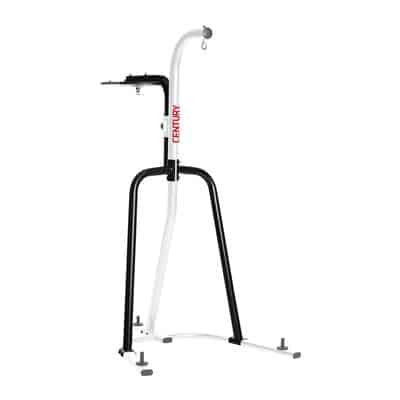With all the options of punching bags available when it comes to boxing at home. It is easy to get overwhelmed with analysis paralysis. When choosing the type of boxing bag for your home, there are some key points to consider which would help you decide what can be a good fit. Let’s take a look at a few pros and cons of a free standing punching bag vs. a hanging punching bag.
A hanging punching bag is an overall better experience, and the go-to option for most boxers. The swaying of the heavy bag movements you can do around really has no substitutes. If boxing is in your workout for the long term whether for fitness or sport. A hanging punching bag would be the choice.
When deciding between a free standing punching bag and a hanging punching bag, the biggest factor would be the space you have. Not that there is much physical size difference between the two types of bags but a boxing bag that needs to be hung, has more requirements to consider. For example, you would need to have a proper support beam or joist in order to hang it from the ceiling. Wall space and supporting studs would be required if you wanted to mount it along a wall. Having this option is may not be available for every home. And it could require some extra work to make it happen.
Typically you would want to hang it in a garage or basement, however, depending on where your support beams are, it would be a challenge to set it up in an ideal spot.
With free standing punching bag, you get a bit more flexibility. You only need floor space and the set up is quick. Moving it around when you’re rearranging or putting it away is simple and convenient.
What Is A Free Standing Punching Bag?
A free-standing punching bag, also known as a stand-up or upright punching bag, is a versatile and portable punching bag that instead of hanging from a ceiling or bag stand, sits one a large base that is typically filled with sand or water.
Free standing punching bags are training equipment used in various combat sports, martial arts, and fitness workouts. Unlike traditional hanging punching bags, a free-standing bag does not require mounting or installation as it stands independently on its own.
The free-standing punching bag is made up of two main components: a sturdy base and an attached striking bag that slides on through a track. The base is wide and provides stability that prevents the bag from tipping over when hit hard.
Most free standing punching bags feature adjustable height settings, allowing users to customize the bag’s height according to their preference or specific training needs.
Pros And Cons Of A Free Standing Punching Bag
Pros of a Free Standing Punching Bag:
- Portability: Free standing punching bags are designed to be portable, allowing users to easily move and position them as desired. This makes them suitable for individuals who want to train in different locations or have limited space.
- Easy Setup: Unlike hanging heavy bags, free standing punching bags do not require installation or mounting. They can be set up quickly and without the need for additional equipment or support structures.
- Stability: Free standing punching bags feature a wide and heavy base that is typically filled with sand or water. This provides stability and prevents the bag from toppling over during intense training sessions, offering a secure target for strikes.
- Versatility: Free standing punching bags allow for a wide range of striking techniques, including punches, kicks, knee strikes, and elbows. Users can practice various martial arts techniques, boxing combinations, or simply engage in a dynamic cardio workout.
- Lower Noise and Vibration: Compared to hanging heavy bags, free standing punching bags generally produce less noise and vibration when struck. This can be advantageous for individuals living in shared spaces or those who prefer a quieter training environment.
Cons of a Free Standing Punching Bag:
- Limited Swinging Action: Unlike hanging heavy bags, free standing punching bags do not swing or move as dynamically when struck. This may provide less realistic feedback and less closely replicate the movement of a live opponent.
- Stability Concerns: Although free standing punching bags are designed to be stable, there is still a possibility of the bag shifting or tipping during intense training. This is especially true if the base is not filled properly or if the user strikes with excessive force.
- Size and Shape Limitations: Free standing punching bags have a fixed shape and size, which may not be suitable for individuals seeking specific training targets or angles. They may not replicate the precise shape of a human body for certain types of training.
- Limited Height Adjustability: While some models offer adjustable height settings, not all free standing punching bags allow for customization of the bag’s height. This may limit the bag’s suitability for users of different heights or those who require specific target heights for training purposes.
- Durability and Maintenance: Free standing punching bags can be susceptible to wear and tear, particularly in the base area where it experiences repeated impacts. Regular maintenance, such as checking for leaks in the base or replacing worn-out parts, may be necessary to ensure longevity.
What Is A Hanging Heavy Bag
A hanging heavy bag, also referred to as a hanging punching bag, is the most common piece of training equipment used in combat sports, martial arts, and fitness training. They are typically hung from the ceiling or a bag stand that allows the bag to sway and move when being hit.
A hanging heavy bag typically wrapped with leather, vinyl, or canvas and filled with dense materials like shredded fabric, sand, foam or a combination of materials to provide the necessary weight and resistance.
Hanging heavy bags come in various sizes and weights to cater to different training goals and skill levels. Lighter bags are suitable for speed and accuracy training, while heavier bags provide a greater challenge for developing power and building strength.
Pros And Cons Of A Hanging Heavy Bag
Pros of a Hanging Heavy Bag:
- Realistic Striking Experience: Training with a hanging heavy bag provides a more realistic simulation of striking an opponent, allowing fighters to develop their technique, power, and accuracy.
- Full Range of Strikes: The hanging heavy bag allows practitioners to practice a wide range of strikes, including punches, kicks, elbows, and knees, helping to improve overall striking skills and versatility.
- Swing and Movement: When struck, the hanging heavy bag swings and moves, mimicking the movement and resistance encountered in real combat scenarios. This helps fighters develop timing, footwork, and adaptability.
- Building Power and Strength: Regular training with a heavy bag helps to develop striking power, strength, and muscular endurance, as the bag absorbs the impact and provides resistance.
- Stress Relief and Cardiovascular Fitness: Striking the heavy bag is an excellent way to release stress and tension. It also provides an intense cardiovascular workout, improving endurance, stamina, and overall fitness.
Cons of a Hanging Heavy Bag:
- Space and Mounting Requirements: Hanging heavy bags require sufficient space and a suitable mounting structure such as a ceiling or beam. Not everyone has access to an appropriate space for installation.
- Noise and Vibration: Hitting a hanging heavy bag can generate noise and vibration, which may cause disturbance or annoyance to others nearby. This can be a concern in shared living spaces or areas with noise restrictions.
- Installation and Maintenance: Hanging heavy bags require proper installation, including mounting the bag securely and ensuring the stability of the hanging apparatus. They may also require periodic maintenance, such as checking the chains or straps for wear and tear.
- Limited Mobility: Unlike free-standing punching bags, hanging heavy bags are not portable. Once installed, they cannot be easily moved or repositioned, which may limit their use for individuals who require mobility or want to train in different locations.
- Potential Joint Stress: Constantly striking a hanging heavy bag can put stress on joints, particularly if proper technique and form are not maintained. It is essential to use correct striking mechanics and gradually increase intensity to avoid injury.
Free Standing Or Hanging Punching Bags If You’re A Beginner
When just starting out with boxing training. A free standing punching bag would be easier to adapt to and to get a feel for what you want. The setup is much simpler, and if any changes need to happen to your home gym or workout space, putting away the stand up punching bag is a breeze.
The total cost of the two options can range a great deal when comparing the two. A free standing punching bag could set you back anywhere from $100-$200. A hanging punching bag alone is within the same price range, however if you factor in the stands or mounts and other equipment that actually gets the bag hanging. You can easily see that number double or triple.
If you feel you are missing the benefits of a hanging bag and you are at the start of boxing training. There really is no major difference from a fitness and early training stand point.
As you get more comfortable and start doing more elaborate boxing workouts. You may start seeing a need to upgrade punching bags. This is a good time in investing in one that hangs either from the ceiling or use a heavy bag stand. Spending the time to build your space would be more worthwhile knowing that you are committed.
Why You Would Want A Free Standing Punching Bag
As we’ve touched on earlier, a standing punching bag or sometimes called a stand up boxing bag, is quite versatile and will meet most your needs for those just starting out. A free standing punching bag is still a great option if you want to incorporate boxing into a workout. For general fitness a free standing punching bag is all you need. You would also want to favour a free standing punching bag when:
- you have limited space
- you like to rearrange a lot
- you’re a beginner and just want boxing to be part of your workout
- you want to avoid any DIY style projects
- you are just looking to get the basics down
- you are boxing for fitness reasons
although not to say that a free standing punching bag is not suitable from someone more advanced in the sport of boxing. As you improve and grow in the sport, a free standing punching bag may begin to seem more limiting.
Go through our process of choosing a standing bag with this article here.
Why You Would Want A Hanging Punching Bag
Hanging bags requires installation into either a wall, ceiling or bag stand. If you don’t shy away from handy work, then this could be the option for you. Hanging a heavy bag should be done properly as to not damage your home or risk injury. And it is also a more permanent piece of equipment after mounting.
- you want a punching bag that can take more force
- you like the swaying motion
- you have a dedicated space for boxing
- you want to improve as a boxer
- you like to move around the bag
A hanging punching bag allows for more room on the floor since it is not being anchored by a heavy base. Because of this, you get more freedom in moving closer to the bag and around it. If you’re the type of boxer that likes the sway motion of a punching bag. Then the hanging bag would be the only way to go. With a free standing punching bag you wouldn’t get much movement. You are more likely to get sliding and shifting from the base along the gym floor.
Our Standing Boxing Bag Recommendation

With all the quality makes on the market, one of the originals was Century and their Wavemaster line. They were one of the first (if not the first) to make boxing at home more convenient with free standing punching bags. A standing punching bag has a base that would need to be filled with either sand or water and that would depend on how much force you plan on giving it.
Some downsides to this bag is that if it is not anchored down and heavy enough. The bag could shift and slide while being used. Meaning you would need to constantly adjust it during your workout. If you are running into this problem, we have an article that covers how to keep your free standing bag from moving here.
As great as standing punching bags are, there are some negatives that everyone should know before deciding. We compiled a list of 10 most common problems that standing punching bags have in our article here.
Our Hanging Bag Recommendation

There are also quite a few options when it comes to hanging heavy bags. And they’re all varied on the quality spectrum. To ensure you still get one with quality that won’t let you down, stick with the Century brand. The Brave 4.0 Heavy Bag and The Creed Heavy Bag are both beginner and intermediate level friendly. These punching bags also come with reinforced nylon straps instead of chains. Making your workouts less intrusive with the noise level as it would tend to be quieter without the chains clanging.

For those who prefer not to drill wholes and place screws in their walls or ceiling, you best option is to get a bag stand along with the punching bag. It will make your set up a bit bulkier but it gives you freedom in where you place your punching bag.
Conclusion
From my personal experience, I started off with the Wavemaster. If I were to do it all again, I would have gotten the bag and stand combo. There was nothing particularly wrong with the free standing bag, and it was great at the time when I was just beginning. However, issues like tipping over and sliding made the experience less enjoyable. I’m 5’9 and at the highest setting, most of my punches were already reaching the top of the bag. You would definitely want to consider an alternative option if you’re over 6 feet.
Although these issues may seem small and easily fixed (and they are). It is something that is “good to know” when deciding on what type of bag to get. After going through these issues, I’ve written some articles to guide you through how to fix them.
How to stop your bag stand from moving.
How to Keep your stand up punching bag from moving.
How to make your heavy bag and stand quieter.
